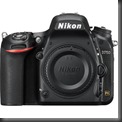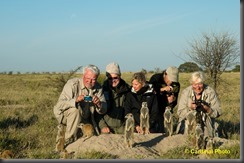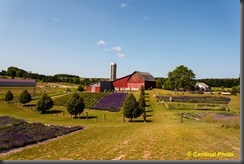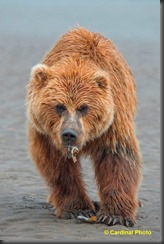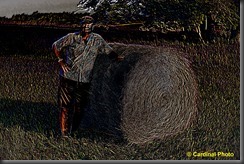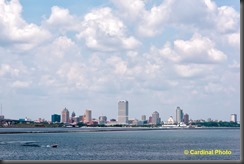Submitted by David Cardinal on Mon, 11/10/2014 - 10:56
I’ve always envied pros wandering around with their classic Domke photo bags. Sleek, practical, and oozing history, they were also rugged enough to take a beating anywhere in the world. However, whether because I needed to lug large lenses, carry a laptop, or have a bag with enough padding so that I could check it in a pinch, there was never a Domke that fit my needs. Until now. The new bag is perfect for a traveling photographers “walk-around” gear and laptop. I’ve been using one for a few weeks, so I have plenty of experiences with it to share with you…
Submitted by David Cardinal on Mon, 11/03/2014 - 11:24
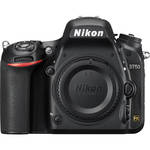 The first impression you get when taking a out of the box is that it is the perfect size and shape for a DSLR (at least for me). It is smaller and lighter than other "semi-pro" models, with a deep hand grip that makes it easy to carry in one hand – even without a strap. It’s no mirrorless or rangefinder, but a pleasant change from larger DSLRs.
The first impression you get when taking a out of the box is that it is the perfect size and shape for a DSLR (at least for me). It is smaller and lighter than other "semi-pro" models, with a deep hand grip that makes it easy to carry in one hand – even without a strap. It’s no mirrorless or rangefinder, but a pleasant change from larger DSLRs.
Submitted by David Cardinal on Mon, 10/20/2014 - 14:32
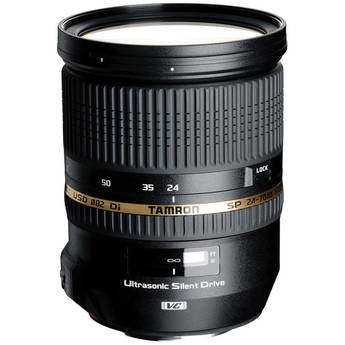 Like most of you, I’m always a bit skeptical of third party lenses until I get to give them a good workout. The need for a fast, but not insanely large, zoom for my recent gorilla trekking experience led me to the (newish) . The specs – lighter and smaller than the Nikon version, with Vibration Compensation included – were appealing. By themselves, that wouldn’t have convinced me to try it. Coupled with its off the charts performance when tested by DxOMark with the Nikon D800e (as close as test as I could find to the I’d be using it with), I was sold on the idea of using it as my go-to mid-range zoom in Africa. I wasn’t disappointed…
Like most of you, I’m always a bit skeptical of third party lenses until I get to give them a good workout. The need for a fast, but not insanely large, zoom for my recent gorilla trekking experience led me to the (newish) . The specs – lighter and smaller than the Nikon version, with Vibration Compensation included – were appealing. By themselves, that wouldn’t have convinced me to try it. Coupled with its off the charts performance when tested by DxOMark with the Nikon D800e (as close as test as I could find to the I’d be using it with), I was sold on the idea of using it as my go-to mid-range zoom in Africa. I wasn’t disappointed…
Submitted by David Cardinal on Sun, 10/19/2014 - 08:36
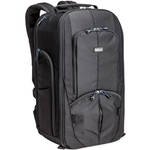 Regular readers will know that for yours I’ve been searching for the perfect backpack for taking on African safaris – or to other locations where we shoot from vehicles. For international travel, the bag has to meet carry-on requirements, so it can’t be too long. It also needs to either be a roller, like the ThinkTank Airport Takeoff or the LowePro X200, or at least have really nice backpack straps for lugging through connecting airports. At the same time, it needs to be compact enough to fit on the seat in a vehicle and move around in potentially tight spaces on boats or trucks. Plus it needs to accommodate a couple bodies, several lenses including a long one, and a laptop. Enter the …
Regular readers will know that for yours I’ve been searching for the perfect backpack for taking on African safaris – or to other locations where we shoot from vehicles. For international travel, the bag has to meet carry-on requirements, so it can’t be too long. It also needs to either be a roller, like the ThinkTank Airport Takeoff or the LowePro X200, or at least have really nice backpack straps for lugging through connecting airports. At the same time, it needs to be compact enough to fit on the seat in a vehicle and move around in potentially tight spaces on boats or trucks. Plus it needs to accommodate a couple bodies, several lenses including a long one, and a laptop. Enter the …
Submitted by David Cardinal on Tue, 10/14/2014 - 11:35
No matter how often you’ve watched it on video, or seen those amazing images of Wildebeest herds crashing down the bank of the Mara River, nothing is quite like the experience of watching it in person. Our group was fortunate enough to witness (and photograph) several crossings on our recent trip. Each one was different, of course, but there is much about crossings that isn’t obvious from the photos, and isn’t featured in most video documentaries that’s worth passing along…
Submitted by David Cardinal on Thu, 10/09/2014 - 07:25
 Upon my return from Africa, I found my review waiting for me. As expected from the specs & early looks, it is a sweet (and relatively small) camera that I’ll have plenty of fun shooting with – and writing about -- over the coming weeks. However, it wasn’t quite what I expected from the model number. I was hoping it would be a real upgrade from the Nikon D700, and might make a good twin for my . However, it isn’t…
Upon my return from Africa, I found my review waiting for me. As expected from the specs & early looks, it is a sweet (and relatively small) camera that I’ll have plenty of fun shooting with – and writing about -- over the coming weeks. However, it wasn’t quite what I expected from the model number. I was hoping it would be a real upgrade from the Nikon D700, and might make a good twin for my . However, it isn’t…
Submitted by David Cardinal on Tue, 09/30/2014 - 05:53
Submitted by David Cardinal on Tue, 09/16/2014 - 06:19
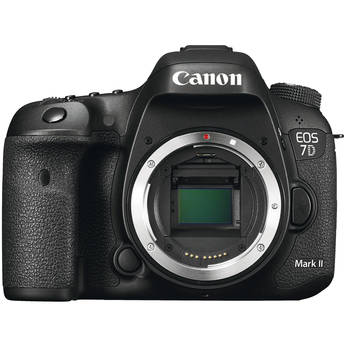 It’s no secret that APS-C (aka DX-format) shooters have been given short-shrift by both Nikon and Canon for the last 5 years. The venerable Canon 7D and Nikon D300 (and the almost identical Nikon D300S) have been amazing cameras, but are more than long in the tooth. Canon has fixed that for its smaller-format loyalists in one fell swoop with the awesomely-speced . That begs the question of whether DX loyalists on the Nikon side should consider jumping ship…
It’s no secret that APS-C (aka DX-format) shooters have been given short-shrift by both Nikon and Canon for the last 5 years. The venerable Canon 7D and Nikon D300 (and the almost identical Nikon D300S) have been amazing cameras, but are more than long in the tooth. Canon has fixed that for its smaller-format loyalists in one fell swoop with the awesomely-speced . That begs the question of whether DX loyalists on the Nikon side should consider jumping ship…
Submitted by David Cardinal on Fri, 09/12/2014 - 08:18
Nikon’s new has something for nearly everyone. State-of-the-art Autofocus, improved 24MP sensor, brand-new, high-performance body design, 6.5 fps full-frame, 100% viewfinder, pro-quality video features, tilting LCD, and a fairly sane price tag of $2300. It is going to be a hard camera to resist for current owners of the Nikon D600, , , and even those who have a Nikon D800 but would love a little more speed and are getting tired of super-large files. I’ll be doing a full field-test when I’m back from Africa, but based on the specs, here are my quick thoughts on pros & cons:
Submitted by David Cardinal on Tue, 09/09/2014 - 16:50
I get asked all the time to give advice about what camera someone should buy. Far less often I sometimes get asked a much more important question – “What do I need to learn how to do with my new camera before I take it on my vacation, or to some special event, and try to use it effectively?” Modern cameras (even many of those found in smartphones) have way too many features for anyone to master them all. But there are 10 basic skills you should learn. If you purchase your camera at a camera store with actual human salespeople (there are still a few), you can probably have them show you most or all of them before you walk out with your new kit:
Submitted by David Cardinal on Thu, 08/21/2014 - 09:30
For the past few weeks I’ve been shooting with a in a variety of situations. I wasn’t enough of a fan of the D800 to purchase one, so I didn’t expect to want to purchase my review either. However, Nikon has done enough to improve the camera that it is now a winner for me, and this one will likely be staying right here in my camera bag. Here’s why…
Submitted by David Cardinal on Wed, 08/13/2014 - 09:53
Every July I return to Alaska to photograph the amazing Coastal Brown (aka “Grizzly”) Bears. Over the course of 15 years I’ve used over a dozen different cameras, and at least that many lenses to capture images. Typically at least one of my lenses would be a massive telephoto (400mm f/2.8 or 200-400 f/4, or 120-300 f/2.8). This year, as part of my ongoing effort to identify lighter, less expensive alternatives to large and extremely expensive lenses, I decided to shoot for the entire two safaris with “just” a attached to my Nikon D610. My hope was to see whether this new, sub-$3K lens could do a good job of subbing for larger, more expensive alteratives….
Submitted by David Cardinal on Mon, 08/11/2014 - 13:50
While having a good painting program isn’t a requirement for most photographers, it can come in handy for sketching out ideas for the “bones” of an image (thanks to John-Paul Caponigro for effectively demonstrating that point to me originally). My favorite when I’m on Windows (or Mac) is ArtRage. The company has just released a solid update to version 4.5. I’ve been using the beta for awhile now and have been quite pleased with the new features…
Submitted by David Cardinal on Thu, 08/07/2014 - 13:07
I’m in the process of comparing the latest versions of various Raw file converters, and as part of that I’ve been rendering the same image in multiple pieces of software and comparing the results. Stay tuned for the scientific version where I use actual color targets and math, but in the meantime, I’ve been trying to get a feel for the differences by eye. However, I found something I didn’t expect…
Submitted by David Cardinal on Wed, 08/06/2014 - 08:53
One of the advances Nikon has made with the is the complete removal of the low-pass (aka anti-aliasing) filter. The Nikon D800e achieved a similar effect by adding a second filter layer to undo the effects of the anti-aliasing filter, but the move to eliminate it completely in the D810 goes a step further. The concern, of course, is the potential for increased moire, or color interference patterns, in small details. To test out the for moire in landscapes, I chose the Milwaukee skyline…
Pages

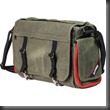
 The first impression you get when taking a
The first impression you get when taking a  Like most of you, I’m always a bit skeptical of third party lenses until I get to give them a good workout. The need for a fast, but not insanely large, zoom for my recent gorilla trekking experience led me to the (newish)
Like most of you, I’m always a bit skeptical of third party lenses until I get to give them a good workout. The need for a fast, but not insanely large, zoom for my recent gorilla trekking experience led me to the (newish)  Regular readers will know that for yours I’ve been searching for the perfect backpack for taking on African safaris – or to other locations where we shoot from vehicles. For international travel, the bag has to meet carry-on requirements, so it can’t be too long. It also needs to either be a roller, like the ThinkTank Airport Takeoff or the LowePro X200, or at least have really nice backpack straps for lugging through connecting airports. At the same time, it needs to be compact enough to fit on the seat in a vehicle and move around in potentially tight spaces on boats or trucks. Plus it needs to accommodate a couple bodies, several lenses including a long one, and a laptop. Enter the
Regular readers will know that for yours I’ve been searching for the perfect backpack for taking on African safaris – or to other locations where we shoot from vehicles. For international travel, the bag has to meet carry-on requirements, so it can’t be too long. It also needs to either be a roller, like the ThinkTank Airport Takeoff or the LowePro X200, or at least have really nice backpack straps for lugging through connecting airports. At the same time, it needs to be compact enough to fit on the seat in a vehicle and move around in potentially tight spaces on boats or trucks. Plus it needs to accommodate a couple bodies, several lenses including a long one, and a laptop. Enter the 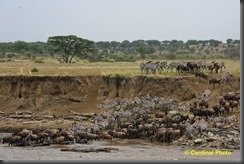
 Upon my return from Africa, I found my review
Upon my return from Africa, I found my review  It’s no secret that APS-C (aka DX-format) shooters have been given short-shrift by both Nikon and Canon for the last 5 years. The venerable Canon 7D and Nikon D300 (and the almost identical Nikon D300S) have been amazing cameras, but are more than long in the tooth. Canon has fixed that for its smaller-format loyalists in one fell swoop with the awesomely-speced
It’s no secret that APS-C (aka DX-format) shooters have been given short-shrift by both Nikon and Canon for the last 5 years. The venerable Canon 7D and Nikon D300 (and the almost identical Nikon D300S) have been amazing cameras, but are more than long in the tooth. Canon has fixed that for its smaller-format loyalists in one fell swoop with the awesomely-speced 